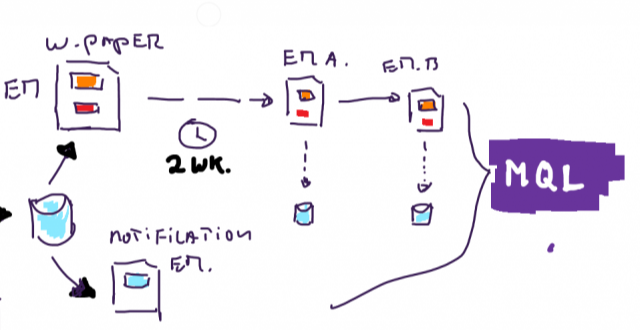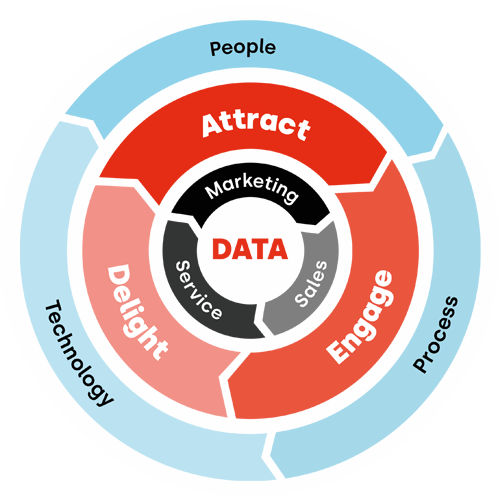Flexible CRM is fundamental to a go-to-market strategy
In collaboration with CustomerTalk - The classic CRM systems currently in use are excellent for traditional enterprise resource planning (ERP) environments, but not for rapidly changing digitally armed markets. Why is that? You'll read about it in this article.
As a result of the COVID-19 pandemic, there has been increased pressure on many commercial teams. In the first quarter of 2020, new ways to interact with - potential - customers had to be found quickly. You therefore saw a lightning-fast adoption of new sales and marketing tools, especially tools that many traditional customer relationship management (CRM) systems do not provide. Think of Zoom, Google Meet or Microsoft Teams for the video calls that everyone is familiar with these days, but very definitely also of new tools that marketing and sales can use to build or maintain customer relationships now that physically - temporarily - can no longer do so. Look at prospecting technologies like Bluebird, Vainu and Leadfeeder, sales enablement platforms like Showpad and Mediafly and collaboration tools like Miro and Slack.
All such tools are brought together each year in the"Martech 5000. This is a term that is now outdated, as there are already more than 8,000 solutions in the form ofsoftware as a service ( SaaS) for commercial support. The pleasing observation is that more and more commercial professionals are adopting these tools. However, the new concepts and other ways of working are often not well supported by the known CRM systems and existing procedures. The conclusion is then quickly drawn: the old ways of working stand in the way of the new approach. But that really can, should and need not be the case anymore.
Do the dominant CRM systems hold up?
Of course, the CRM vendors see this happening too. There are so many new developments in this field that they are almost tripping over the trends and developments. In any case, they shout around the loudest thatartificial intelligence ( AI) is baked in, that you can flawlessly shape youraccount-based marketing strategy with it , and that their system also uses state-of-the-art chatbots.
However, let's face it, most CRM systems are mostly built on pre-Internet era foundations and are therefore severely outdated. Then you can still try to add lots of bells and whistles to such a system, but in fact that foundation is finite. At its core, it will always be cumbersome and frustrating rather than facilitating.
![]()
8,000 tools for marketing and sales, are you still there? Source: chiefmartec.com
Many frictions in the execution of a go-to-market strategy
Ago-to-market strategy is actually your plan to sell an agreed number of a specific product or service within a given time. You do this primarily with the disciplines of marketing and sales, which must therefore work closely together to achieve this goal. However, that is only part of the solution. Where we mostly see problems arising is not so much the human will to collaborate but much more the concrete-cast processes and systems that make flexible collaborations impossible.
The route can often be drawn and imagined. However, if this route then needs to be organized, you get bogged down by a company's system limitations and IT policies. Is IT going to organize commerce with terms like IT target architecture, primary processes, missing functionalities and data silos? You could easily spend six months discussing that. The solution mainly lies in a service-oriented IT department that knows how to manage the tools for marketing and sales - and not the other way around....
The traditional CRM systems currently in use are excellent for traditionalenterprise resource planning ( ERP) environments but not for rapidly changing digitally armed markets. To determine whetherkey performance indicators ( KPIs) have been met, the data are often too fragmented and reside in different systems and databases. It is insufficient to track your activities manually. Digital commercial tools provide the data to create complete targets that can be managed strategically and tactically.
So how should it be done?
The misery of many IT systems is that they are deeply rooted in companies' processes. In some cases, the systems are even the processes. This, of course, makes it extra difficult to make the desired changes. Therefore, it is necessary to make a very clear split between the CRM for the back end of an organization - the back office - and the front end of an organization - the front office. The CRM that you have set up for the back office processes, we often leave alone in ago-to-market strategy. At most, we make a data link, which allows us to consult inventory or schedules, for example.
If you want an effective and quickly agile, modern, scoring front office, then you almost have no choice but to adopt anoutside-in approach. We mean an approach based entirely on the - potential - customers and their customer journey. We first define theideal buyer profiles and establish thecustomer journey of various personas. On this basis, we set up the internal marketing and sales processes and translate them through the system that is ideally suited for this:HubSpot's CRM. Where this platform does not provide the righttooling, it is possible to use Vainu, Vidyard or Hotjar, for example. But as mentioned, there are hundreds of solutions where it comes down to yourgo-to-market approach. The tools should support and not dictate in that strategy.

Want to get the most out of HubSpot? Subscribe to our newsletter, follow us on LinkedIn, or attend our HubSpot User Days!
Explore HubSpot User DaysShare this
You May Also Like
These Related Stories

Lead generation in B2B: Generating leads effectively, how?

What is CRM (Customer Relationship Management)?

